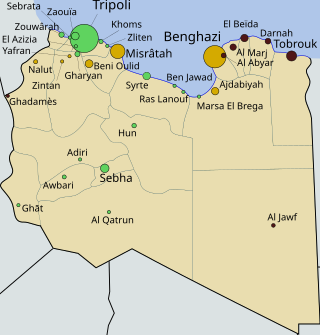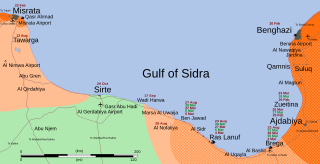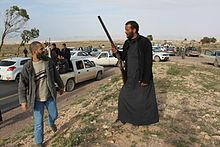
Sirte, also spelled Sirt, Surt, Sert or Syrte, is a city in Libya. It is located south of the Gulf of Sirte, between Tripoli and Benghazi. It is famously known for its battles, ethnic groups, and loyalty to Muammar Gaddafi. Due to developments in the First Libyan Civil War, it was briefly the capital of Libya as Tripoli's successor after the Fall of Tripoli from 1 September to 20 October 2011. The settlement was established in the early 20th century by the Italians, at the site of a 19th-century fortress built by the Ottomans. It grew into a city after World War II.
Brega, also known as Mersa Brega or Marsa al-Brega, is a complex of several smaller towns, industry installations and education establishments situated in Libya on the Gulf of Sidra, the most southerly point of the Mediterranean Sea. It is located in the former Ajdabiya District, which in 2007 was merged into the Al Wahat District. The town is the center of Libya's second-largest hydro-carbon complex.

The National Liberation Army, officially the National Liberation Armed Forces of the Free Libyan Republic, formerly known as the Free Libyan Army, was a Libyan military organisation affiliated with the National Transitional Council, which was constituted during the First Libyan Civil War by defected military members and civilian volunteers, in order to engage in battle against both remaining members of the Libyan Armed Forces and paramilitia loyal to the rule of Muammar Gaddafi. Its self proclaimed chief commander was General Khalifa Haftar, although the National Transitional Council preferred to appoint Major General Abdul Fatah Younes Al-Obeidi as its commander-in-chief. It had prepared for some time in portions of Eastern Libya controlled by the anti-Gaddafi forces for eventual full-on combat in Western Libya against pro-Gaddafi militants, training many men before beginning to go on the offensive. They have battled for control of Benghazi, Misrata, Brega, Ajdabiya, Zawiya and Ra's Lanuf as well as several towns in the Nafusa Mountains. They finally began the Battle for Tripoli in August 2011 when they attacked from the west of the city, as well as fomenting an internal uprising on 20 August.
The Battle of Ras Lanuf was a two-phase battle in 2011 during the Libyan Civil War between forces loyal to Libyan leader Muammar Gaddafi and those loyal to the National Transitional Council. Both forces sought control of the town of Ras Lanuf. The first phase followed two days after the First Battle of Brega which occurred in the town Brega, roughly 130 kilometres (81 mi) to the east of Ras Lanuf. After conquering the town on 4 March, the rebels pushed further west to attack Sirte but they were driven back by government forces and on 11 March, government troops reconquered most of Ras Lanuf.
Bin Jawad, also known as Bin Jawwād, Bin Quwad is a town with estimated 8,488 inhabitants in the Sirte District in Libya. It is approximately halfway between Benghazi and Misrata. The nearest settlements are Nofaliya, which about 20 km to the west, and the port of Sidra, which is about 30 km to the southeast of Bin Jawad.
The Second Battle of Brega took place during the Libyan Civil War. More than 10 days earlier, anti-Gaddafi forces beat back an attempt by loyalist forces to take the town on 2 March 2011, in the First Battle of Brega. Following that battle, rebel forces advanced along the Libyan Coastal Highway, taking the towns of Ra's Lanuf and Bin Jawad. However, after the Battle of Bin Jawad and the Battle of Ra's Lanuf, government troops retook all of the territory lost and were once again threatening Brega by mid-March.

The Second Battle of Benghazi took place during the Libyan Civil War between army units and militiamen loyal to Libyan leader Muammar Gaddafi, and anti-Gaddafi forces in Benghazi. The battle marked the start of a United Nations-mandated military intervention in the conflict, with fighter jets from the French Air Force attacking and destroying several pro-Gaddafi units, forcing them to retreat.
The Third Battle of Brega was fought during the Libyan Civil War between government forces and anti-Gaddafi forces for control of the town of Brega and its surroundings.

The First Gulf of Sidra offensive was the second major rebel offensive of the Libyan Civil War. It was mounted by anti-Gaddafi forces immediately after their victory in the Battle of Ajdabiya. The offensive was meant to have the rebel forces quickly reach Gaddafi's hometown of Sirte.
The Battle of Bin Jawad took place during the Libyan Civil War between forces loyal to Libyan leader Muammar Gaddafi and anti-Gaddafi forces for control of the town of Bin Jawad.
The Fourth Battle of Brega was a battle during the Libyan Civil War between forces loyal to Muammar Gaddafi and forces of the Libyan opposition for control of the strategic town of Brega and its oil port.
The Battle of Brega–Ajdabiya road was a battle during the Libyan Civil War between forces loyal to Libyan leader Muammar Gaddafi and anti-Gaddafi forces for control of the towns of Brega and Ajdabiya respectively and the Libyan Coastal Highway between them.
The Battle of Ajdabiya was an armed battle in and near the city of Ajdabiya that took place as part of the Libyan Civil War. It was fought between anti-government rebels and military forces loyal to the Libyan leader Muammar Gaddafi. Following the Second Battle of Brega, in which pro-Gaddafi forces captured the town, Ajdabiya was the only major rebel-held city left en route to the rebel capital of Benghazi. The battle for Ajdabiya had been cited as a potential turning point in the conflict on which the fate of the whole rebellion against the Gaddafi government may be decided. On 26 March 2011, Libyan rebels, backed by extensive allied air raids, seized control of the frontline oil town of Ajdabiya from Colonel Muammar Gaddafi's forces. During the first phase of the battle, pro-Gaddafi forces seized the strategic road junction leading to Benghazi and Tobruk, and captured most of the city. The city centre remained in rebel hands but was surrounded by pro-government forces and cut off from outside assistance. After the second phase, anti-Gaddafi forces recaptured the road junction and cleared loyalist forces from the city, sending them retreating down the Libyan Coastal Highway towards Sirte.

The Libyan Civil War began on 15 February 2011 as a chain of civil protests and later evolved into a widespread uprising against the regime of Muammar Gaddafi. On 25 February, most of eastern Libya was reported to be under the control of protesters and rebel forces. Gaddafi remained in control of the cities of Tripoli, Sirte and Sabha. By 15 March, however, Gaddafi's forces had retaken more than half a dozen lost cities. Except for most of Cyrenaica and a few Tripolitania cities the majority of cities had returned to Gaddafi government control.

The timeline of the Libyan civil war begins on 15 February 2011 and ends on 20 October 2011. The conflict began with a series of peaceful protests, similar to others of the Arab Spring, later becoming a full-scale civil war between the forces loyal to Muammar Gaddafi's government and the anti-Gaddafi forces. The conflict can roughly be divided into two periods before and after external military intervention authorized by United Nations Security Council Resolution 1973.

The Libyan Civil War began on 15 February 2011 as a civil protest and later evolved into a widespread uprising. However, by 19 March, Libyan forces under Colonel Muammar Gaddafi were on the brink of a decisive victory over rebels in Libya's east. That day, leading NATO members acted on United Nations Security Council Resolution 1973 which authorized member states "to take all necessary measures... to protect civilians and civilian populated areas under threat of attack in the Libyan Arab Jamahiriya, including Benghazi, while excluding an occupation force".

The Second Gulf of Sidra offensive was a military operation in the First Libyan Civil War conducted by rebel anti-Gaddafi forces in August and September 2011 to take control of towns along the Gulf of Sidra in an effort to surround Muammar Gaddafi's hometown of Sirte, which was held by pro-Gaddafi forces. It ended on 20 October, with the capture and execution of Muammar Gaddafi and his son Mutassim Gaddafi, along with former defense minister Abu-Bakr Yunis Jabr. The Gaddafi loyalists in the area were finally defeated when NTC fighters captured Sirte.
The raid onRas Lanuf was a hit-and-run attack carried out in the early morning of 12 September 2011 by two groups of fighters loyal to Muammar Gaddafi in an apparently coordinated effort to disrupt oil refinery and export operations in the National Transitional Council-administered port town of Ra's Lanuf, Libya, during the Libyan Civil War.

The 2011 Libyan Civil War began on 17 February 2011 as a civil protest and later evolved into a widespread uprising. After a military intervention led by France, the United Kingdom, and the United States on 19 March turned the tide of the conflict at the Second Battle of Benghazi, anti-Gaddafi forces regrouped and established control over Misrata and most of the Nafusa Mountains in Tripolitania and much of the eastern region of Cyrenaica. In mid-May, they finally broke an extended siege of Misrata.







